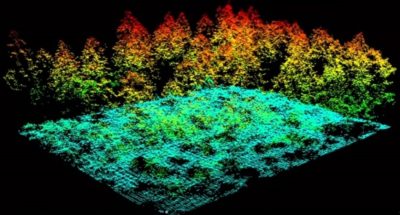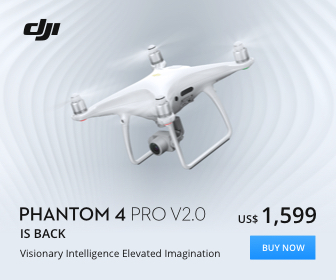Lidar sensors on UAVs capture imagery which only a few years ago needed an aircraft carrying large heavy lidar sensors and a crew to accomplish.
Here, we look at 12 of the best lidar sensors for drones along with the best lidar drones.
We feature lidar sensors from manufacturers such as Velodyne, Routescene, Leddartech, Riegl, YellowScan, Leica and Geodetics.
The lidar drones include quadcopters, fixed wing drones, UAV helicopters from manufacturers such as DJI, Harris, Velos, Vulcan, OnyxStar and many more.
A lidar sensor mounted on a UAV, along with the lidar software can process images very quickly in the cloud, allowing for effective decisions to be made by stakeholders and relevant parties.
The output from these lidar drones and sensors is outstanding. The pace of development and improvement in the lidar sensors over the past few years has been tremendous and will continue with more entrants into this sector.
Over the coming years, we are going to see most of the lidar sensor work moving from aircraft to lidar drones.
In fact, all the manufacturers of the large lidar sensors for airplanes have developed smaller lidar sensors for drones.
We start off this post with the lidar drones being used for the various sensors, followed by how lidar sensor technology works. Then, we look at the best lidar sensors for drones. Along the way, we have some terrific lidar drone sensor videos.
We also discuss some of the many great uses of lidar technology and how each lidar sensor works well in the different sectors such as mining, forestry, surveying, corridor mapping etc.
There are so many terrific uses for drones including drones mounted with lidar sensors. Here is an excellent article, which shows you all the many uses for drones to date.
Lidar Drones
Here is the list of the lidar drones being used to carry the most popular lidar sensors detailed below;
- DJI M600 Pro lidar quadcopter
- Draganflyer Commander
- Riegl RiCopter Lidar UAV
- Harris H4 Hybrid HE UAV
- VulcanUAV Harrier Industrial
- VelosUAV helicopter
- Robota Eclipse fixed wing drone
- DJI Matrice 200 Series quadcopter
- OnyxStar Xena drone lidar
- OnyxStar Fox-C8 HD quadcopter
- GeoDrone X4L lidar quadcopter
- Tron F9 VTOL fixed wing lidar
- Boreal long range fixed wing drone
- Vapor 55 UAV helicopter
The DJI Matrice 600 and 600 Pro can be used to carry many different lidar sensors. Many solutions require a lidar sensor and also another sensor such as RGB camera for photogrammetry or a multispectral sensor mounted on the drone to capture the images for the particular solution. So in choosing a drone, the payload capacity of both a lidar sensor and RGB camera needs to be taken into consideration.
Lidar Drone Full Solution Providers
If you need a full lidar drone solution, then the below providers have packages and expertise to put a full solution together for you.
- DraganFly UAS
- Phoenix Lidar Systems
- LidarUSA
- Riegl Laser Measurement Systems
- Xena OnyxScan Advanced Lidar Systems
About Lidar Sensor Technology
Lidar – Light Detection and Ranging or Lidar is a remote sensing technology where the environment is scanned with a pulsed laser beam and the reflection time of the signal from the object back to the detector is measured.
The Time-of-Flight (ToF) reflection time measurement can be used over distances from one meter up to several kilometers. To increase the range of lidar systems, very short laser pulses in the invisible Near Infrared range are used. These enable a far higher laser power compared to continuous wave lasers, while still complying with eye safety requirements.
During the scanning process, the lidar system will gather individual distance points within an aggregate of points, from which 3D images of the environment can be computed. The laser scanners deflect the laser beam using deflecting mirrors, which enable them to achieve very wide fields of vision (FoV).
Most of the latest UAV lidar systems can rotate around their own axis and offer 360 degree visibility. Modern devices achieve very high data rates with over one million distance points per second.
How Lidar Sensors Works In Brief
- Emission of a laser pulse
- Record of the back scattered signal
- Distance measurement (time of flight x speed of light)
- Retrieving plane position and altitude
- Computation of precise echo position
UAV Lidar Sensor Uses
Lidar Sensors For Drone Collision Avoidance
Within a lidar sensor, a number of independent elements are integrated into a single device and will generate critical ranging data for safe navigation along with precise positioning. Lidar sensors have obstacle detection capabilities over a wide field of view, which make them ideal as part of a sense and avoid solution. Lidar is the leading technology for automobile collision avoidance and also in driver-less cars.
Collision avoidance technology has now moved across into the consumer drone sector with the highly innovative DJI Mavic 2 (sensors on all sides), DJI Phantom 4 Pro V2 (using 2 Ultrasound sensors and 4 monocular sensors) and the Yuneec Typhoon H Pro (uses the Intel RealSense R200 3D camera) now with collision avoidance.
Lidar Sensors For Ground And Above Ground Imagery
The latest lidar sensors have integrated optical altimeter technology which deliver accurate distance measurements above ground level while meeting size, weight and cost requirements of UAV manufacturers.
Agriculture and forestry use lidar to inspect vegetation such as leaves and crops. Also, the above ground imagery (for example forest canopy) can be removed to view the ground surface area.
Lidar Drones For Structural Inspection
The best lidar sensors have powerful built-in signal processing, large field of view and multi-segment measurements which generate critical distance data and efficient obstacle detection, which enable safe navigation when performing structural inspections.
Lidar Sensor At Night
Lidar sensors also described as laser scanning will work in low contrast or shadowy situations, even at night.
Lidar UAV Uses In Brief
- Agriculture and forestry
- Archaeology and cultural heritage documentation
- Corridor mapping: power line, railway track, and pipeline inspection
- Topography in open-cast mining
- Construction site monitoring
- Building and structural inspections
- Surveying of urban environments
- Resource management
- Collision avoidance
- Shoreline and storm surge modeling
- Hydrodynamic modeling
- Digital Elevation Models
Multispectral and Photogrammetry Imagery
Lidar, multispectral and photogrammetry imagery are all very closely related technologies. In some sectors and situations, images from all 3 are required to give a full analysis of the terrain, vegetation or structure. To read further on these technologies see the following articles:
- UAVs In The Lidar Applications Sector Increases Substantially
- Introduction To UAV Photogrammetry And Lidar Mapping Basics
- Multispectral Imaging Drones In Farming Yield Big Benefits
- Multispectral Remote Sensing Drones For Golf Course Vitality
ToF 3D Cameras (Flash Lidar)
Now, sometimes you might hear people talk about Flash Lidar. Time-of-Flight cameras sensors are often referred to as Flash Lidar. But there are big differences in LiDAR and Flash LiDAR technology and its uses.
ToF flash lidar is scannerless, meaning that the entire scene is captured with a single light pulse, as opposed to point-by-point with a rotating laser beam.
Time-of-flight flash lidar cameras capture a whole scene in three dimensions with a dedicated image sensor, and therefore has no need for moving parts. ToF has so many great uses. Here is a terrific article called “ToF flash lidar cameras and best uses” which gives you all the information on ToF flash lidar and it terrific uses. The article includes some excellent knowledgeable videos on ToF flash lidar.
10 Top Lidar Sensors For UAVs
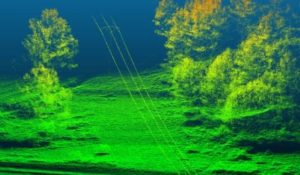 The below lidar sensors were designed and engineered for small UAVs. Use the web links to each lidar sensor for more information. Each of the manufacturer have excellent websites which will give you full data sheets along with the best uses for their lidar sensors.
The below lidar sensors were designed and engineered for small UAVs. Use the web links to each lidar sensor for more information. Each of the manufacturer have excellent websites which will give you full data sheets along with the best uses for their lidar sensors.
LeddarTech Lidar Sensors
Vu8 Lidar Sensor
The LeddarTech Vu8 is a compact solid-state lidar which provides highly accurate multi-target detection over eight independent segments. Detecting targets at up to a 215 meter range and weighting only 75 grams, the Vu8 delivers nearly twice the range for half the volume compared with the Leddar M16 from which it inspires.
The Vu8 uses a fixed laser light source, which significantly increases the sensor’s robustness and cost-efficiency. The Vu8 has a high tolerance to noise and interference. This means it is unaffected by other sensors’ signal, by lighting conditions including direct sunlight, and it provides reliable detection in various weather conditions including rain and snow.
The Vu8 sensor is particularly suited for navigation and collision avoidance applications in driver-assisted, semi-autonomous and autonomous vehicles, such as drones, trucks, heavy equipment for construction and mining, shuttles, buses and other public transportation vehicles.
Applications such as Advanced Traffic Management System (ATMS) requiring longer ranges as well as wide fields of view will also benefit greatly from the new Vu8 sensor.
Features and Benefits of the Vu8 Lidar Sensor
- Detection range up to 700 feet (215 meters)
- Compact and lightweight (75 grams)
- 8 independent segments with simultaneous acquisition and lateral discrimination capabilities
- 20°, 48° and 100° beam width options, for optimized field of view
- Rapid refresh rate up to 100 Hz
- Immune to ambient light
- No moving parts, for ultimate robustness
- Easy to integrate, includes Leddar Enabler SDK
- Based on the modular LeddarVu platform for flexible integration and customization
- Best cost/performance ratio
LeddarOne Lidar Sensor
This LeddarOne lidar sensor is a full-beam sensor module which is entirely dedicated to a single point measurement which makes it ideal for applications such as level sensing, security and surveillance, drone altimeter and presence detection.
The LeddarOne can be easily integrated into almost any system. The module’s compact size, low power consumption and high accuracy gives developers and integrators great flexibility to enhance their own products.
Features of the LeddarOne Lidar Sensor
- 0 to 40 meter detection range
- Compact and lightweight 0.5 ounces (14 grams)
- Rapid data acquisition time, up to 140 Hz
- Proven reliability, even in harsh conditions
- No moving parts, for ultimate robustness
- Low power consumption
- 3-degree, diffuse beam
- Very compact (2” diameter)
- Immune to ambient light
- Easy to integrate, includes Leddar Enabler SDK
- Best cost/performance ratio
You can read more on the LeddarOne here which, includes full specifications and the many uses for this small compact lidar sensor.
Lidar Drone For LeddarOne and Vu8 Sensors
DraganFlyer Commander – this drone is ideal for the Leddartech LeddarOne and Vu8 lidar sensor. These lidar sensors weight are very light so you don’t need a massive drone to carry them.
This DraganFlyer Commander drone is a high performance, high endurance, electric powered, autonomous helicopter featuring a patented carbon fiber folding airframe and interchangeable payloads for a variety of mission types.
-
- 35 minute flight time
- Dual battery system
- Quick release payloads
- Folding air frame
- Autonomous flight
- Long range
- max speed 31 mph (50 km/h)
- Flight planning software
- Complete ready-to-fly system
- Aircraft weight 2.7 kg (6 lbs)
- Payload capacity 1 kg (2.2 lbs)
Robota Eclipse 2.0 – This fixed wing UAV is an excellent solution with applications in agriculture, construction, mining, urban analysis, lidar imagery and much more. Read this Robot Eclipse paper this fixed wing drone was used with lidar technology for drone altimeter applications.
This 1st video also shows you what the LeddarOne is used for and how it works.
Velodyne Lidar Sensors
Velodyne produce 4 of the best lidar sensors for UAVs with a full line of sensors capable of delivering the most accurate real-time 3D data on the market. Their sensors are developed to create a full 360 degree field of vision environmental view for use in autonomous vehicles, industrial equipment, 3D mapping and surveillance. Velodyne have 3 lidar sensors for UAVs.
HDL-32E Lidar Sensor
The HDL-32E LiDAR sensor is small, lightweight, ruggedly built and features up to 32 lasers across a 40 degree vertical field of view. The HDL-32E measures only 5.7″ high x 3.4″ in diameter, weighs less than 2 kg and was designed to exceed the demands of the most challenging real world autonomous navigation, 3D mobile mapping and other lidar applications.
- Dual returns
- ± 2 cm accuracy
- 2.86 lbs (1.3 kg) with cabling
- 32 channels
- 80 – 100 meter range
- 700,000 points per second
- 360° horizontal FOV
- +10° to -30° vertical FOV
- Low power consumption
- Rugged design
- Weighs less than 2 kg (4.4 lbs)
Puck VLP-16 Lidar Sensor
Velodyne’s new PUCK™ VLP-16 lidar sensor is the smallest, newest, and most advanced product in Velodyne’s 3D lidar product range. It is more cost-effective than similarly priced sensors and developed with mass production in mind.
It retains the key features of Velodyne’s breakthroughs in lidar: Real-time, 360 degree horizontal FOV, 3D distance and calibrated reflectivity measurements.
- Dual returns
- 16 channels
- 100 meter range
- 300,000 points per second
- 360 degree horizontal FOV
- ± 15° vertical FOV
- Low power consumption
- Protective design
- Weight of 1.82 lbs (830 grams)
Puck Lite Lidar Sensor For UAVs
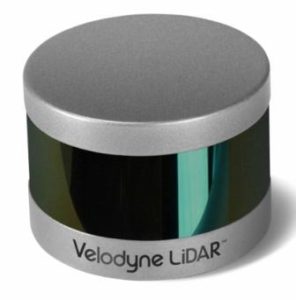 Velodyne LiDAR’s Puck LITE™ is a lighter weight version of the VLP-16 PUCK for applications that demand a lower weight to meet their requirements. The Puck LITE™ has identical performance to VLP-16 with the only difference in weight of 590 grams (1.3 lbs) versus 830 grams for the VLP-16.
Velodyne LiDAR’s Puck LITE™ is a lighter weight version of the VLP-16 PUCK for applications that demand a lower weight to meet their requirements. The Puck LITE™ has identical performance to VLP-16 with the only difference in weight of 590 grams (1.3 lbs) versus 830 grams for the VLP-16.
No other changes have been made to the Puck LITE™ as it retains its patented 360 degree surround view to capture real-time 3D lidar data which includes distance and calibrated reflectivity measurements.
Here is a terrific video which explains how lidar is being used and what the Velodyne lidar sensors can do.
Puck Hi-Res Lidar Sensor For UAVs
Expanding on Velodyne VLP-16, the Puck Hi-Res is used in applications which require greater resolution in the captured 3D image. Puck Hi-Res retains the VLP-16 Puck’s 360° horizontal field-of-view (FoV) and 100-meter range.
However, the Puck Hi-Res also delivers a 20° vertical FoV for a tighter channel distribution with 1.33° between channels instead of 2.00°, giving greater details in the 3D image at longer ranges. This will enable the host system to not only detect, but also better discern, objects at these greater distances.
Velodyne Puck Hi-Res Lidar Sensor Features
- 300,000 points per second
- 360° horizontal FOV
- Low power consumption
- Protective design
- Connectors: RJ45 / M12
- Weight: ~1.3 lbs (590 grams) without cabling and interface box
Lidar Drones For Velodyne Lidar Sensors
DJI Matrice 600 Pro – This M600 Pro multirotor drone from DJI has a weight has a weight of 22 lbs (10 kg) without any payload. It’s maximum payload is 34 lbs (15.5 kg) making it ideal for carrying any of the above Velodyne lidar sensors. This would also allow for another sensor to be mounted along with the Velodyne.
Phoenix Aerial, DraganFly UAS and Lidar USA solutions providers all use the DJI Matrice 600 Pro for full solutions.
DJI M200 V2 has a max payload of 3.2 lbs (1.45 kg) and is an absolutely tremendous drone for any enterprise.
Velos UAV helicopter – This Velos can fly for 65 minutes and has a 22 lb (10 kg) may payload weight along with a 12 mile (20 km) max radio control range. It has a max speed of 80 mph (km/h) and flies very well in windy conditions.
Harris H4 Hybrid HE – The Carrier H4 Hybrid HE is a gas-electric hybrid drone. This quadcopter can be configured to carry a variety of different sensory payloads such as HD zoom cameras, thermal imaging cameras, multispectral cameras, and LiDAR. The recommended payload for the Carrier H4 HE is 4.4 lbs (2 kg), allowing for up to 2.5 hours of flight.
LidarUSA use all the above to provide full lidar drone solutions.
Riegl – VUX-1UAV LiDAR Sensor
Laser scanning utilizing high-end unmanned airborne platforms provides the possibility to acquire data in dangerous and/or hard to reach areas, while offering an excellent cost to benefit ratio for numerous applications, e.g., precision farming, forestry, and mining.
For years, Riegl Airborne Laser Scanners have been successfully used in powerful unmanned airborne platforms. With the VUX-1UAV airborne scanner and the RiCOPTER which is Riegls’s remotely piloted aircraft system for Unmanned Laser Scanning (ULS), Riegl have revolutionized the commercial and civil market with its advanced systems.
The Riegl VUX-1UAV (former VUX-1) is a very lightweight and compact lidar laser scanner, meeting the challenges of emerging survey solutions by UAS/UAV/RPAS, both in measurement performance as in system integration.
With regard to the specific restrictions and flight characteristics of UAS, the Riegl VUX-1UAV is designed to be mounted in any orientation and even under limited weight and space conditions.
It is modest in power consumption with the instrument requiring only 1 power supply. The entire data set of an acquisition campaign is stored onto an internal 240 Gigabyte SSD and/or provided as real-time line scan data via the integrated LAN TCP / IP interface.
VUX-1UAV Lidar Sensor Main Features:
- 10 mm survey grade accuracy
- Scan speed up to 200 scans per second
- Measurement rate up to 500,000 measurements per second (@ 550 kHz PRR & 330° FOV)
- Operating flight altitude up to more than 1,000 feet
- Field of view up to 330 degree for practically unrestricted data acquisition
- Regular point pattern, perfectly parallel scan lines
- Cutting edge Riegl technology providing;
– echo signal digitization
– online waveform processing
– multiple-time-around processing - Multiple target capability – practically unlimited number of targets echoes
- Compact (227 x 180 x 125 mm), lightweight (3.5 kg) and rugged
- Easily mountable on professional UAS / UAV / RPAS
- Mechanical and electrical interface for IMU mounting
- Electrical interfaces for GPS data string and Sync Pulse (1 PPS)
- LAN-TCP/IP interface
- Scan data storage on internal 240 gigabyte SSD memory
VUX-1UAV Lidar Sensor Main Applications
- Agriculture and forestry
- Archaeology and cultural heritage documentation
- Corridor Mapping: power line, railway track and pipeline inspection
- Topography in Open-Cast mining
- Construction-site monitoring
- Surveying of urban environments
- Resource management
Lidar Drone For Riegl VUX-1UAV Lidar Sensor
DJI Matrice 600 Pro – This multirotor drone has a weight of 22 lbs (10 kg) without any payload. It’s maximum payload is 34 lbs (15.5 kg) making it ideal for carrying any of the above Riegl lidar sensors. This would also allow for another sensor to be mounted along with the Riegl. LidarUSA use the DJI M600 to carry the Riegl VUX-1UAV lidar sensor.
Riegl RiCopter Lidar UAV – This is a complete miniaturized airborne laser scanning system solution. The system consists of the RIEGL VUX-1UAV laser scanner, an IMU/GNSS system, a control unit and up to 2 optional cameras.
The excellent measurement performance of the VUX-1UAV in combination with a precise fiber optic gyroscope and GPS/GLONASS receiver results in survey grade measurement accuracy.
Vapor 55 UAV – This helicopter UAV provides infinite payload flexibility for a variety of sensors or dual sensor configurations including lidar, multispectral, thermal and high resolution electro optical camera systems. It is recommended for the Riegl VUX-1UAV lidar sensors. The Vapor 55 can fly up to 60 minutes with a 11 lbs (5 kg) payload.
This next video shows the Riegl’s ready to fly RiCopter UAV laser scanning system which is equipped with the survey grade VUX-1UAV lidar sensor.
Routescene – UAV LidarPod
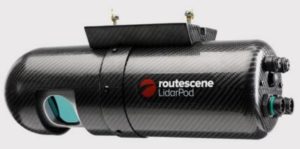 The Routescene UAV LidarPod is a complete turnkey system developed specifically for use on UAVs. This company worked with the surveying industry and it’s their expertise which is behind the Routescene UAV LidarPod.
The Routescene UAV LidarPod is a complete turnkey system developed specifically for use on UAVs. This company worked with the surveying industry and it’s their expertise which is behind the Routescene UAV LidarPod.
Routescene designed a reliable, practical and cost-effective solution for lidar applications. The UAV LidarPod is a robustly engineered and self contained system. It is simple to operate and enables rapid deployment in the field. The turnkey solution includes LidarViewer which is the specialized software to handle the resulting data.
The LidarPod sensor combines the best technology on the market to capture survey grade positional accuracy together with a very high point cloud density.
Points Per Second
The Routescene LidarPod will collect 700,000 points per second, which at an altitude of 40 meters (131 feet) and flying speed of 30 km per hour (18.64 mph) equates to 300 points per square meter. This offers a fantastic richness in the data set which greatly enhances the detail which can be collected.
LidarPod Is Very Light
The Routescene UAV LidarPod total weight is less than 2.5 kg (5.5 lbs). This low weight will enable a 20 minute flight duration, the typical time required to perform a survey, allowing coverage of 1 square km on a single set of batteries.
Quality And Level Of Resilience
The Routescene UAV LidarPod contains all you need to collect precise survey data, quality control the data in real-time and create a very dense and accurate geo-referenced point cloud. This means everything you need is built into the system including the lidar sensor, GPS / INS, radio telemetry, data storage and power management. No external components are necessary which eliminates the possibility of integration issues and loose connectors.
The internal firmware controls the sensors, parses the raw data and transmits data samples to the Routescene Ground Station; it also manages and monitors power consumption of the LidarPod.
The LidarPod uses the Velodyne HDL-32e lidar sensor mentioned above which delivers unsurpassed image resolution. Highlights of the Velodyne HDL-32e within the LidarPod;
- 32 laser sensors / detector pairs
- Class 1 eye safe
- 905 nm wavelength
- Time of flight distance measurement with intensity
- 700,000 3D points per second
- Maximum Range: 100 meters with range accuracy of < 20 mm
- Field of View: 360 degree vertical and 41 degree horizontal
- Angular resolution (vertical): 1.33 degrees
- Shock: 500 m/sec2 amplitude, 11 msec duration
- Environmental Protection: IP67
Processing Lidar Data
Routescene have developed specialized software called LidarViewer, which enables you to easily import, visualize, and apply filters to the large volume of data you collect in a smart way, enabling the use of GIS and CAD packages thereafter.
LidarPod GPS \ INS
A state of the art integrated Real-Time Kinematic (RTK) GPS and Inertial Navigation System (INS) provides accurate position, velocity, acceleration and orientation under the most demanding conditions. The dual antenna moving baseline Real Time Kinetmatic (RTK) GNSS solution ensures that the LidarPod can achieve the highest accuracy possible for the lowest weight.
The GPS\INS sensor combines temperature calibrated accelerometers, gyroscopes, magnetometers and a pressure sensor with a multi channel RTK GNSS receiver. These are coupled in a sophisticated fusion algorithm to deliver accurate and reliable navigation and orientation.
Triple-frequency GNSS receiver that provides up to 1 cm accuracy positioning and supports all of the current and future satellite navigation systems, including GPS, GLONASS, GALILEO (European Satellite Navigation System) and BeiDou (Chines Satellite Navigation System). It also supports the Omnistar service for hassle free high accuracy positioning.
UAV Mounting Kit (optional)
A specially designed and tested solution for mounting the LidarPod and 2 GPS antennas onto your rotary UAV. The mounting kit includes an equipment plate which is compatible with 12 mm diameter UAV equipment rails, the 2 rails being 160 mm apart. The equipment plate includes quick release clamps for easy deployment.
Lidar Drone For Routescene Sensor
Vulcan UAV Harrier Industrial – The Harrier Industrial range covers an ever increasing number of variants aimed firmly at industrial applications, and cover flight weights up to 77 lbs (35 kg). The Vulcan Harrier drones vary in size and configuration but are most commonly X8 folding frames that are highly adaptable to different roles, flight characteristics and payloads.
Common features are a number of quick release anti vibration mounts, quick detach fixed landing gear, custom gimbals and payload mounts, parachutes, proximity sensors and more.
One of the variants of the Vulcan UAV Harrier is an X8 configuration fitted with the RouteScene LidarPod. A set of quick detach fixed landing gear is used to allow the Pod to be easily removed and cased while still installed in the landing gear, making for quick and simple deployment and secure transportation.
You can read on how the Vulcan UAV are being used in various sectors including lidar here.
YellowScan – 3 UAV Lidar Sensors
YellowScan design and develop ultra compact and lightweight lidar 3D laser mapping and aerial remote sensing solutions for drone deployment in industrial & scientific applications.
YellowScan have their own software called “LiveStation” which enables you to monitor in real-time the validity and quality of the data being collected by the YellowScan LiDAR sensors to ensure the survey is going smoothly
Benefit of YellowScan UAV Lidar Sensors
- Scanning Vegetation & Crops: YellowScan’s technology is one of the few to get true distance to vegetation in near real-time. Scan fast growing vegetation and crops as frequently as needed.
- Optimized Maintenance Operations: Quick, light and easy to mobilize, the whole system (UAV+Lidar) can be carried in car trunk or airplane luggage: ideal for quickly surveying limited sections of the network which has not or can’t been scanned with large airborne lidar (sections missed, hard-to-access areas, fast growing vegetation sections).
- Security: YellowScan UAV mapping allows for quick and complete acquisition while eliminating manned airborne or on the ground logistics.
The Yellow Scan Lidar Solutions are aimed towards;
- Small areas (less than 10 square km or 100 km linear)
- Need to penetrate vegetation
- Hard-to-access zones
- Data needed in near real-time / frequently / regularly
- Accuracy range of 5-50 cm
YellowScan Vx Long Range Lidar Sensor
The Vx is an excellent solution for high flight UAV projects with short-time data processing needs. It is ideal for use in the following sectors;
- Forestry
- Civil engineering
- General topography
- Corridor mapping
- Agriculture
- Mining
The YellowScan Vx Benefits & Specifications
- High range for higher security on uneven landscapes and vegetation
- Survey grade precision and accuracy
- Robust and reliable
- Turn-key and simple to operate
- Fully autonomous, can be mounted quickly on any drone
- Precision : 1 cm
- Accuracy : 2.5 – 5 cm depending on IMU
- Laser scanner frequency : 100 kHz
- Weight : 2.5 – 3 kg battery included (5.5 – 6.6 lbs) depending on IMU
- Power Consumption : 25 Watt
- Autonomy : 1.5 hours
- Size (mm) : L330 x W120 x H150
YellowScan Mapper 2 Drone Lidar Sensor
The YellowScan Mapper lidar sensor is a lightweight turn key surveying solution for drones and other ultra-light aircraft. It’s a small size and ultra-light weight allow it to be mounted on most UAVs.
Yellow Scan Mapper Applications
- Corridor mapping
- Environment works
- Archaeology
- Forestry
Yellow Scan Mapper Lidar Sensor Benefits
- Tested and operated by professionals world wide in various scenarios
- Robust and reliable
- Turn-key and simple to operate
- Open architecture with inter-operable software: fits many applications from research to industrial mapping
- Fully autonomous and can be mounted quickly on any drone
Yellow Scan Mapper Specifications
- Precision: 10 cm
- Absolute accuracy: 15 cm
- Laser scanner frequency: 40 kHz
- Weight: 2.1 kg battery included
- Power consumption: 10 watts
- Autonomy: 2 hours typical
- Size (mm): L172 x W206 x H147
YellowScan Mapper Lidar System Includes
- High-end Attitude and Heading Reference System (AHRS) allowing precision measurement of the attitude
- Dual-frequency GNSS receiver, capable of operating in RTK or PPK positioning mode
- Multi-echo laser scanner
- On-board computer for continuous data acquisition and processing
- Battery (up to 2 hours of autonomy)
- Worldwide technical and operational support
YellowScan Surveyor UAV Lidar Sensor
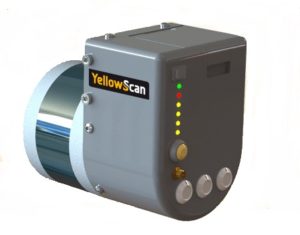 The YellowScan Surveyor is one of the lightest and most accurate lidar sensor solutions for Civil Engineering & Mining professionals. This YellowScan Lidar UAV surveying solution has the highest level of accuracy and density which is also capable of producing real-time geo-referenced point cloud data.
The YellowScan Surveyor is one of the lightest and most accurate lidar sensor solutions for Civil Engineering & Mining professionals. This YellowScan Lidar UAV surveying solution has the highest level of accuracy and density which is also capable of producing real-time geo-referenced point cloud data.
YellowScan Surveyor is a fully integrated system designed for the most demanding of terrains. The YellowScan Surveyor is quick and easily adapted to any drone.
Now, the YellowScan Surveyor does not replace the YellowScan Mapper mentioned above, but complements the YellowScan Mapper with a solution ideally suited for precise topography and demanding requirements for civil engineering and mining applications.
Yellow Scan Mapper Lidar Benefits
- Designed by surveyors for surveyors
- Robust and reliable
- Turnkey, quick and simple to operate
- Fully autonomous and can be quickly mounted on any drone
- Sub-scale decimetric accuracy for highest density level data in demanding survey applications
YellowScan Mapper Lidar Specifications
- Precision: 4 cm
- Absolute accuracy: 5 cm
- Laser scanner frequency: 300 kHz
- Weight: 1.6 kg (3.5 lbs) battery included
- Power consumption: 15 watts
- Autonomy: 2 hours typical
- Size (mm): 100 x 150 x 140
Lidar Drones For YellowScan Sensors
YellowScan have designed their lidar systems to be mounted on the huge variety of drones including multirotors, fixed wing and helicopter UAVs. You can view the YellowScan drones for lidar here and below I will give you a brief over view of these drones.
DJI Matrice 600 Pro – This multirotor drone has a weight of 22 lbs (10 kg) without any payload. It’s maximum payload is 34 lbs (15.5 kg) making it ideal for carrying any of the above YellowScan lidar sensors.
XENA OnyxScan – The lidar drone can be operated across many sectors and applications including lidar imagery. It has a flight time of 27 minutes carrying a 2.2 lbs (1 kg) with a maximum recommended payload of 4.4 lbs (2 kg).
XENA is a strong drone capable of flying safely and efficiently even in windy situations.
It has 8 motors, meaning this drone is powerful and redundant. This lidar drone is equipped with cutting edge flight electronics such as Geofencing, waypoint navigation, failsafe and automatic navigation calculation.
OnyxStar Fox-C8 HD – this is a tremendous multi purpose UAV. It is capable of operating various tasks across numerous sectors. The FOX-C8 HD can lift up to 6.6 lbs (3 kg) which is incredible for such a small sized drone. It also has a flight time of 34 minutes.
GeoDrone X4L – This quadcopter is designed especially for land survey, mapping, forest, agriculture and lidar imaging. The flight weight with imaging capability starts from 8.8 lbs (4 kg) and it is able to map over 100 hectares during a single flight. It has an outstanding flight time of 68 minutes.
The GeoDrone X4L is recommended for the YellowScan Surveyor lidar sensor.
Tron F9 VTOL – This fixed wing lidar drone from Quantum Systems can carry a 4.4 lbs (2 kg) payload and has a maximum flight time of 90 minutes.
It has some tremendous technology built in such as;
- Geotagging during the flight for various post processing options (Rinex data compatible).
- The 2.4 Ghz telemetry data transmission enables BVLOS flight distances with full control capability.
- Geo referencing on the go using iBase, which is an entry level GNSS reference station used to reach the data geotagging relative precision down to 2-5 cm.
- Automatically integrate Live-Air-Traffic-Info into QBase.
Boreal Long Range UAS – This is a tremendous fixed wing long range drone. It is capable of carrying up to 11 lbs (5 kg) of payload for missions of more than 10 hours.
With a wingspan of 4.20 meters and a takeoff weight of less than 55 lbs (25 kg), the BOREAL has an endurance that allows it to travel up to 620 miles (1000 km) during a flight, in conditions of remarkable stability for a aircraft of its category.
Vapor 55 UAV – This helicopter UAV provides infinite payload flexibility for a variety of sensors or dual sensor configurations including lidar, multispectral, thermal and high resolution electro optical camera systems. It is recommended for YellowScan lidar sensors. The Vapor 55 can fly up to 60 minutes with a 11 lbs (5 kg) payload.
Leica Geosystems Lidar Sensors
Leica Geosystems are renowned for the Imaging and Lidar sensors. Their Lidar systems offer high accuracy due to their best-in-class performance in pulse and scan rate.
While they have multispectral and imaging sensors which are mounted on UAVs, their Airborne lidar sensors are large and heavy. Leica have 1 airborne lidar sensor which is too heavy for small UAVs. Their large and heavy lidar sensors for manned aircraft is the Leica SPL100 Single Photo lidar sensor which weighs in at 183.3 lbs (84 kg).
I would expect Leica to start designing small UAV lidar sensors in the near future. They have all the technology and this market is growing massively.
Geodetics – Drone Lidar Sensors
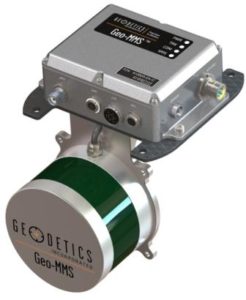 Geodetics was founded in 1999 by a team of scientists with the goal of providing precise positioning technologies in the civilian market.
Geodetics was founded in 1999 by a team of scientists with the goal of providing precise positioning technologies in the civilian market.
Since that time, Geodetics has grown into a product and integrated solution provider for Positioning, Navigation and Timing systems for a wide range of civilian and defense applications.
Their products and systems have been deployed in mission critical applications including Aerial Refueling, Aerial Combat Training, Intelligence, Surveillance and Reconnaissance, UAVs, Aerostats and Dismounted Soldier tracking.
Geo-MMS SAASM Drone Lidar Sensor
The Geodetics Geo-MMS SAASM is a fully integrated lidar mapping payload for integration with small unmanned vehicles. The Geo-MMS system includes an inertial navigation system, utilizing a SAASM GPS sensor with a path to M-Code, coupled with a lidar sensor.
Raw data from the integrated GPS, IMU and lidar sensors are recorded on the internal data recording device and can be post-processed using Geodetics’ lidar tool software package to directly geo-reference the lidar point clouds.
Geo-MMS SAASM Specifications
- Flexible mounting for different platforms including UAV, UAS, ground vehicles and robots
- Minimized sensor size and weight to meet payload restrictions (5 lbs minimum payload)
- Available with a many IMU’s to support a wide range of application requirement
- Centimeter-level position accuracy (dual-frequency RTK configuration)
- On-board data logging of all sensor and navigation solution data
- User interface to fully control individual and collective GPS, IMU, Laser setting
- Full post-processing support for GPS/IMU/LiDAR with RTD-Post and CYO
- LAS file output
Geo-MMS SAASM Lidar Applications
- Intelligence, Surveillance and Reconnaissance (ISR)
- Situational Awareness
- Sense and avoid
- Asset management
- Coastal surveillance
- Hydrometric mapping
- Critical Oil & Gas infrastructure inspection
- DEM/DSM generation
- Indoor mapping capable (SLAM)
Geo-MMS Drone Lidar Mobile Mapping System
The Geodetics Geo-MMS is a fully integrated lidar mapping payload for integration with small unmanned vehicles. The Geo-MMS includes an inertial navigation system coupled with a lidar sensor. Raw data from the integrated GPS, IMU and lidar sensors are recorded on the internal data recording device.
They can then be post-processed using Geodetics’ lidar tool software package to directly geo-reference the Lidar point clouds with LAS format output. Geo-MMS is available with a wide range of sensors.
Geo-MMS Specifications
- Flexible mounting for different platforms including UAV, UAS, ground vehicles and robots
- Minimized sensor size and weight to meet payload restrictions (5 lbs minimum payload)
- Available with a many IMU’s to support a wide range of application requirement
- Centimeter level position accuracy (dual-frequency RTK configuration)
- On-board data logging of all raw and navigation solution data
- User interface to fully control individual and collective GPS, IMU, Laser setting
- Full post-processing support with GPS/IMU Geo post-processing
- LAS file output
Geo-MMS Lidar Applications
- Intelligence, Surveillance and Reconnaissance (ISR)
- Situational Awareness
- Sense and avoid
- Asset management
- Coastal surveillance
- Hydrometric mapping
- Critical Oil & Gas infrastructure inspection
- DEM/DSM generation
- Indoor mapping capable (SLAM)
Lidar Drones For Geodetics Sensors
DJI Matrice 600 – This M600 Pro multirotor drone from DJI has a weight has a weight of 22 lbs (10 kg) without any payload. It’s maximum payload is 34 lbs (15.5 kg) making it ideal for carrying any of the above Velodyne lidar sensors. This would also allow for another sensor to be mounted along with the Velodyne.
Here a quick overview of Geodetics products at the AUVSI’s Xponential.

